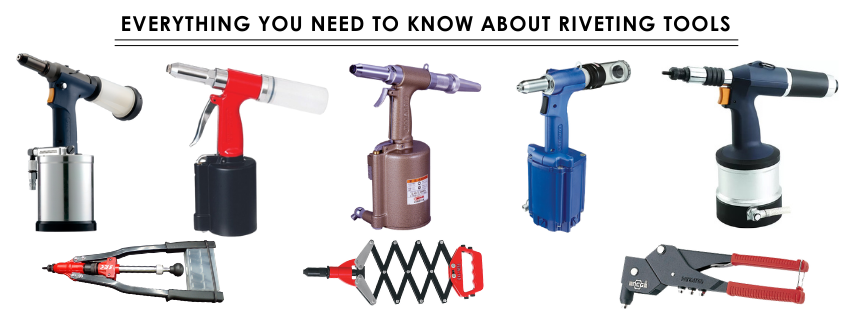When it comes to creating strong, permanent joints in construction, metalwork, automotive repair, or even home DIY projects, few fastening methods are as reliable as riveting. And at the heart of riveting are the tools that make it all possible.
In this post, we’ll break down what riveting tools are, the different types available, how they work, where they’re used, and tips for getting the most out of them—whether you’re a seasoned pro or just getting started.

💡 What Are Riveting Tools?
Riveting tools are devices used to install rivets, which are mechanical fasteners that join materials together permanently. Unlike bolts or screws, rivets can’t be removed without damaging the joint, making them ideal for long-lasting applications.
From simple hand-held tools to high-powered industrial machines, there’s a riveting tool for just about every job.
🧰 Types of Riveting Tools
Here’s a look at the most common types of riveting tools and what they’re best used for.
Manual Rivet Guns (Hand Riveters)
Perfect for small jobs and DIY work, manual riveters are simple, inexpensive, and easy to use.
- Best for: Light-duty metalwork, home repairs
- Pros: Portable, low-cost
- Cons: Requires physical effort
Lever Riveters
An upgrade from basic hand riveters, these use longer handles to give more leverage.
- Best for: Larger rivets and thicker materials
- Pros: Easier to use, more force
Cons: Still manual, but more effective
Pneumatic Riveting Tools (Air Riveters)
These tools use compressed air to install rivets with speed and precision.
- Best for: Industrial, automotive, and assembly line work
- Pros: Fast, consistent, less effort
- Cons: Needs air compressor, less mobile
Hydraulic Riveters
Hydraulic rivet tools are heavy-duty machines that generate immense force for thick materials and large rivets.
- Best for: Aerospace, heavy equipment, shipbuilding
- Pros: Extremely powerful
- Cons: Expensive, not portable
Battery-Operated (Cordless) Riveters
Modern and portable, these tools are powered by rechargeable batteries, offering a good balance between power and convenience.
- Best for: On-site jobs, maintenance, mid-to-heavy duty tasks
- Pros: Cordless, efficient, fast
- Cons: Battery life limitations, higher cost
🔩 Common Types of Rivets
Depending on your project, you’ll want to pair the right tool with the right rivet:
- Blind Rivets (Pop Rivets) – Installed from one side only; common in construction and automotive.
- Solid Rivets – Super strong and durable; used in aerospace and heavy industries.
- Semi-Tubular Rivets – Easier to set than solid rivets; ideal for light-duty fabrication.
🏗️ Where Are Riveting Tools Used?
You’d be surprised how many industries rely on riveting tools:
✈️ Aerospace
Aircraft frames and panels use thousands of rivets. Precision tools like squeeze riveters and pneumatic guns ensure strong, vibration-resistant joints.
🚗 Automotive
Riveting is key in attaching car body panels, chassis parts, and interiors. Speed and consistency are crucial, so pneumatic or battery-operated tools are the go-to.
🏢 Construction
Riveting is essential in HVAC ducts, sheet metal framing, and more. Riveting offers strength without the heat and warping risks of welding.
🔧 Metal Fabrication
In manufacturing, rivets hold together casings, enclosures, and machine parts. Solid, semi-tubular, and blind rivets are all used here.
🛠️ DIY & Home Projects
Installing gutters, repairing trailers, or building with aluminum? A basic hand rivet gun might be all you need.
✅ Advantages of Riveting Tools
Why choose rivets over screws or welds? Here are a few reasons:
- Permanent strength: Rivets form tight, vibration-resistant joints.
- No heat: Unlike welding, riveting doesn’t require high temperatures.
- Consistent performance: Great for repetitive or automated jobs.
- Wide material compatibility: Rivets can join metal, plastic, wood, and more.
⚠️ Things to Consider
While versatile and strong, riveting isn’t always the perfect solution:
- Not removable: Once installed, rivets are permanent.
- Access issues: Some tools require access to both sides of the joint.
- Tool-specific: You’ll need the right tool for the rivet type and size.
🛠️ Pro Tips for Using Riveting Tools
Want clean, professional results? Keep these tips in mind:
- Match your tool and rivet – Not all riveters work with every rivet type.
- Pre-drill accurate holes – Make sure holes are the correct size and clean.
- Use proper safety gear – Always wear eye protection.
- Test on scrap first – Especially if you’re new to riveting.
- Store tools properly – Clean and maintain your riveter to extend its life.
🔧 Maintenance: Keeping Your Riveting Tool in Shape
- Clean after use: Remove debris and metal bits.
- Lubricate moving parts: Especially for air or hydraulic models.
- Check for wear: Replace worn jaws, tips, and parts regularly.
- Recharge batteries: For cordless models, follow manufacturer guidelines.
🚀 What’s Next in Riveting Technology?
Riveting is evolving with automation. From robotic riveting arms to smart tools with torque sensors, technology is pushing the boundaries of what rivets can do. Expect quieter, cleaner, and more efficient riveting tools in the near future—especially in industries aiming to reduce noise and emissions.
📌 Final Thoughts
Riveting tools are the unsung heroes of modern assembly and construction. Whether you’re joining thin sheet metal in your garage or assembling aircraft wings, the right tool can make all the difference.
Choosing the best riveting tool depends on your specific project needs, materials, and frequency of use. But no matter your skill level, mastering these tools unlocks new possibilities for durable and professional-looking work.

